Today, Badami is an ordinary, squalid town. At first sight, it won’t impress you. Grungy, chock-a-block roads, lanes, and by-lanes crammed with dingy slums, and rowdy market areas – Badami hardly resembles its once dominant status as the prosperous capital of the Early Chalukyas.
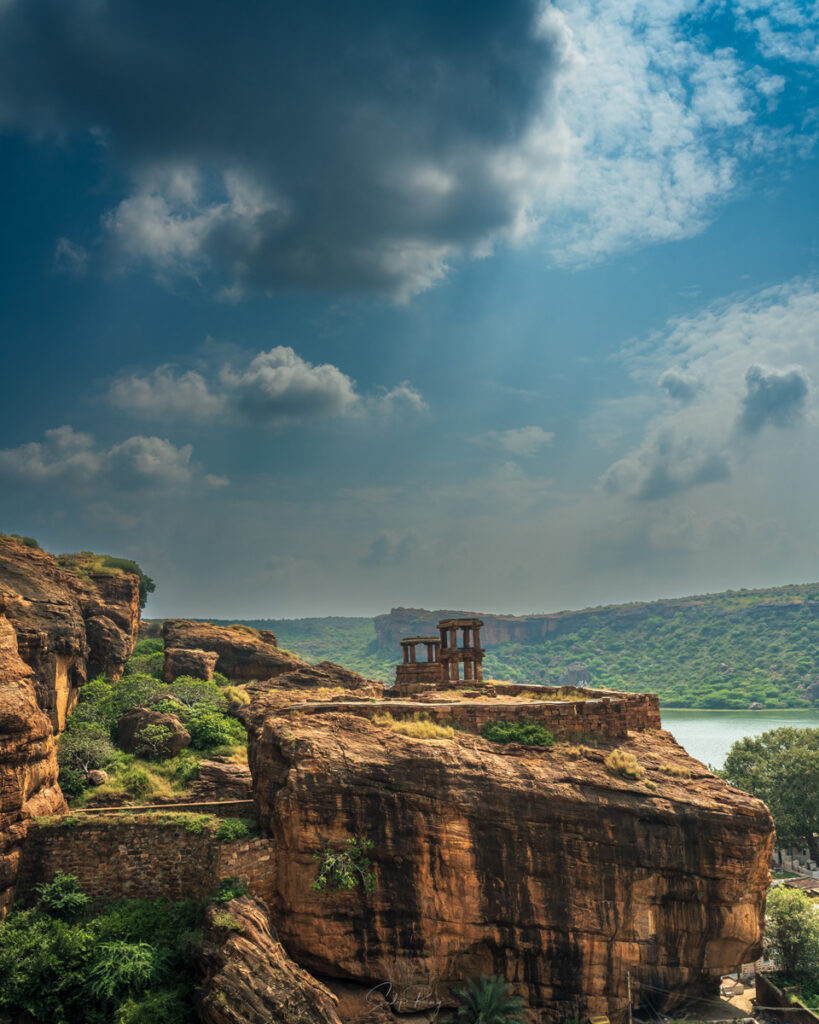
For understanding Badami’s centuries-old history and heritage, you need to head out beyond its dusty main roads. Badami’s mythical origin can be traced in the placid water of Agastya Lake, its monumental rise in history is etched on the cliffs of North Fort, while its architectural legacy is carved on the rocks of South Fort. Truly, there’s more to Badami than the eyes meet.
Table of Contents
About Badami:
The origin of Badami can be traced to mythology. According to legend, two demon brothers, Vatapi and Ilvala, lived here. For preying on humans, Vatapi would turn into a goat, and Ilvala would cook him and offer it to the human. Afterward, Vatapi would regenerate inside the stomach, tearing himself out from the inside thereby killing the victim. When the powerful sage Agastya arrived near a lake, Vatapi and Ilvala played the same sequence. However, Agastya was known for his enormous ingestion and digestion prowess. As such, as soon as Agastya ate Vatapi, he digested him thereby killing Vatapi. Hence, Badami was previously known as Vatapi, and the lake came to be known after Agastya.
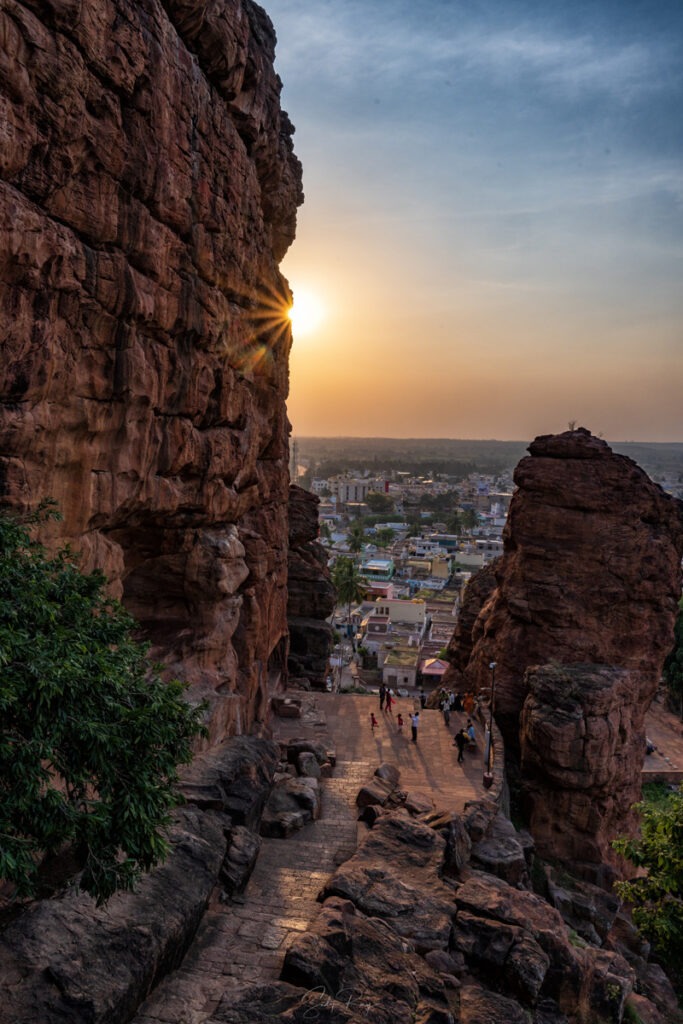
Later, Pulakesin I founded the Chalukya dynasty and made Vatapi his capital. Inscriptions suggest that he made fortifications in Vatapi in 544. Gradually, Vatapi became one of the centers of power in Deccan under Kirtivarmana I, Mangalesha, and the greatest of the Early Chalukyas, Pulakesin II.
Not only this, Badami, along with Aihole and Pattadakal became the flourishing center of art and architecture, as evident from the brilliant craftsmanship of Badami’s Cave Temples.
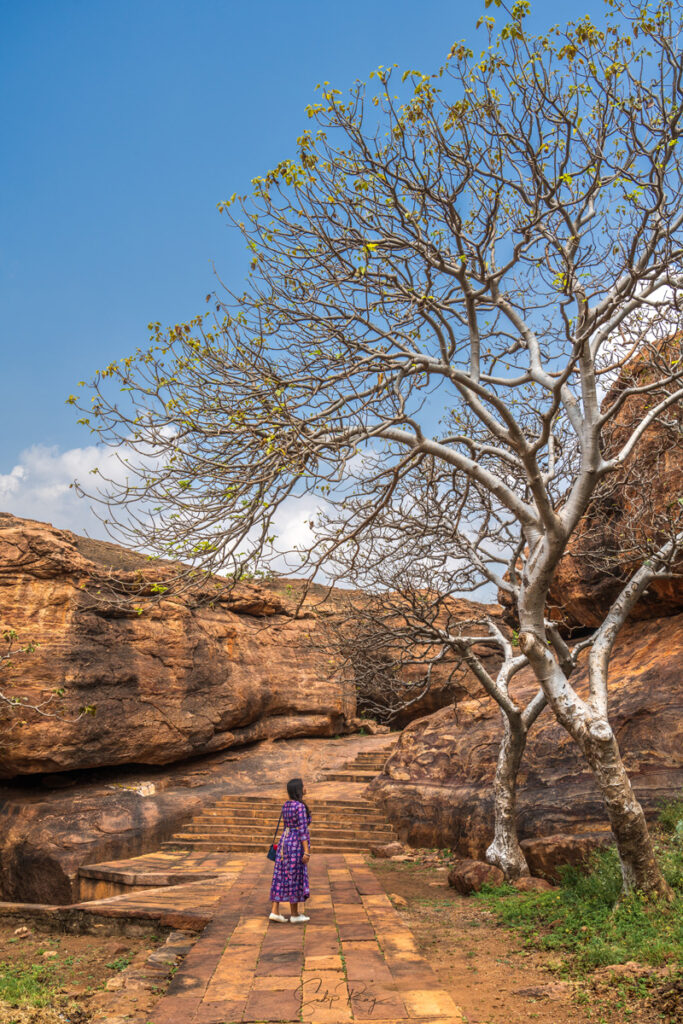
Where is Badami located:
Badami is situated in the Malprabha river valley, in the Bagalkot district of Karnataka. The distance of Badami from some important places is as follows:
From Bengaluru: 448 km
From Hampi: 141 km
From Aihole: 35 km
From Pattadakal: 21 km
From Bijapur: 122 km
From Mysuru: 534 km
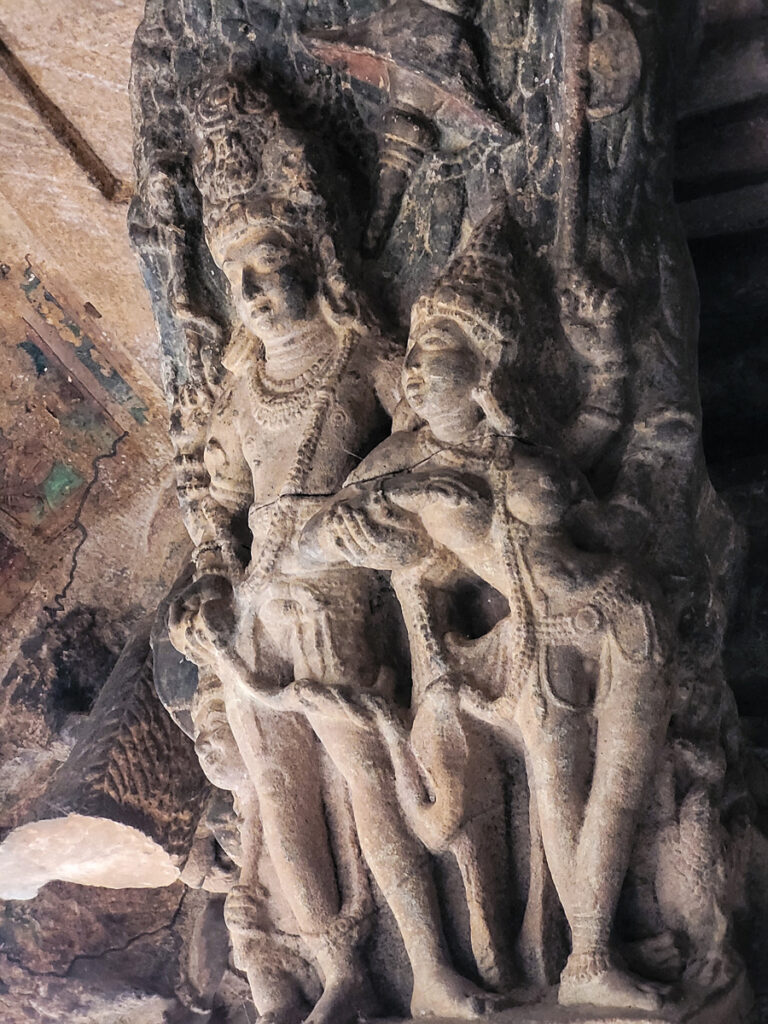
How to reach there:
- By railway: Badami has a rail station, which is well-connected with major places of Karnataka such as Bengaluru, Mysuru, and Bijapur.
- By air: The nearest airport is Hubli, which is 105 km away from Badami.
- By road: Bus service to Badami is available from various parts of Karnataka.
What is the best time to visit Badami:
October to February is the most suitable time for traveling to Badami. The weather remains scorching hot for the rest of the year.
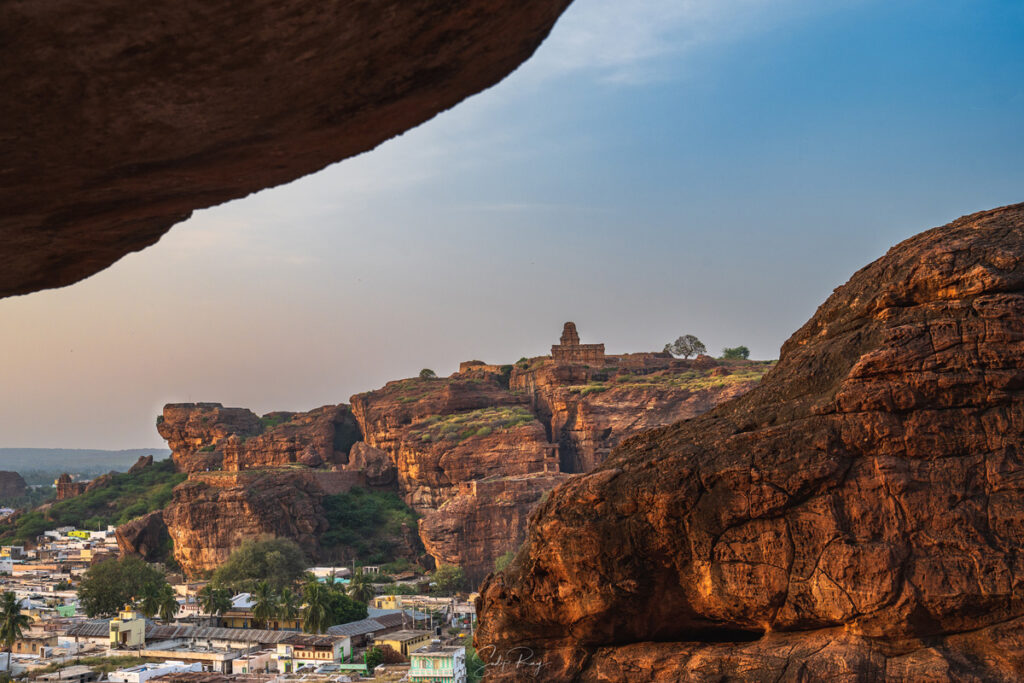
Where to stay in Badami:
In the Badami-Aihole-Pattadakal tourism circuit, Badami is the only place to have decent places for overnight stays. We stayed at the KSTDC run Mayura Chalukya. The room was good enough and the food was satisfactory. The staffs were also cordial and always ready to help.
There are some private hotels also, such as Clarks Inn Badami.
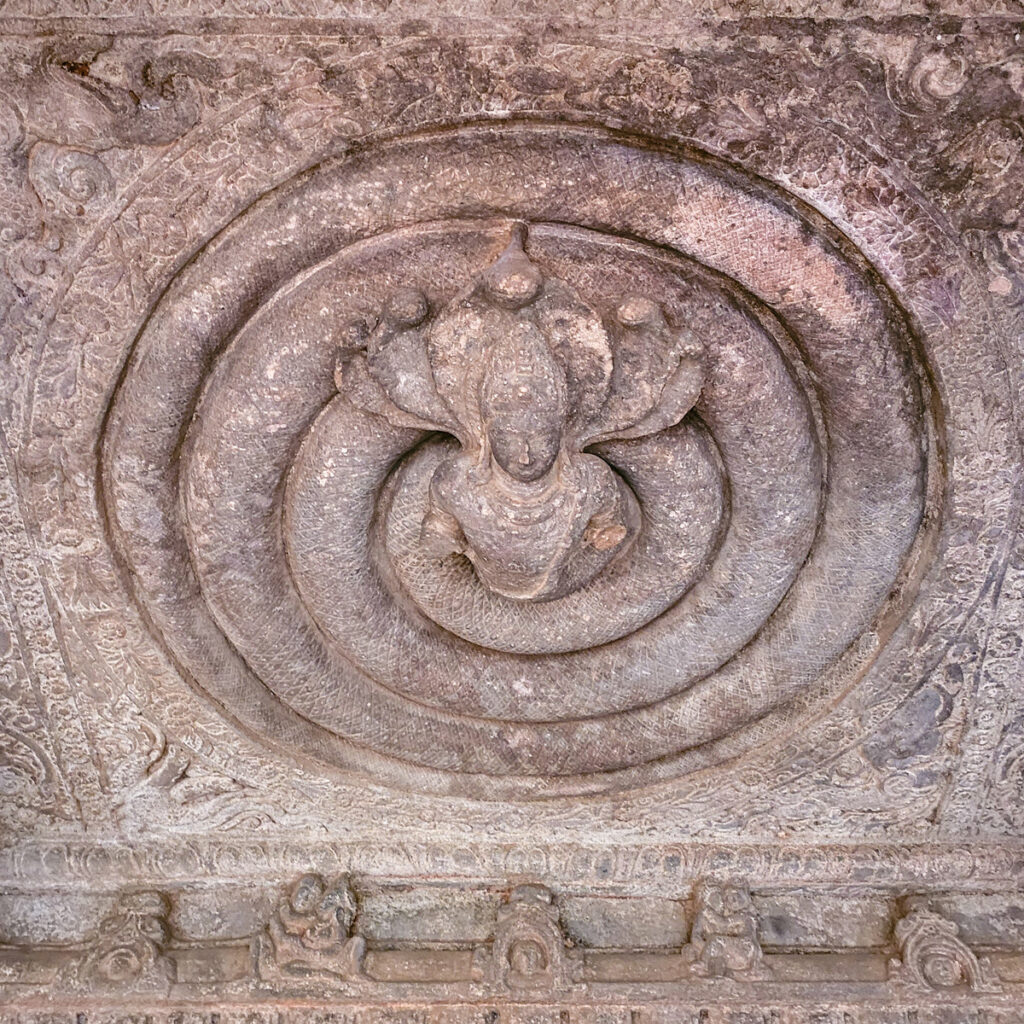
What to see in Badami:
Badami hosts some splendid specimens of Early Chalukyan art and architecture. The main attraction is obviously the Cave Temples in the South Fort. Along with this, there are the Bhootnatha Group of Temples, Agastya Lake, North Fort with Upper and Lower Shivalayas, and the Archaeological Museum.
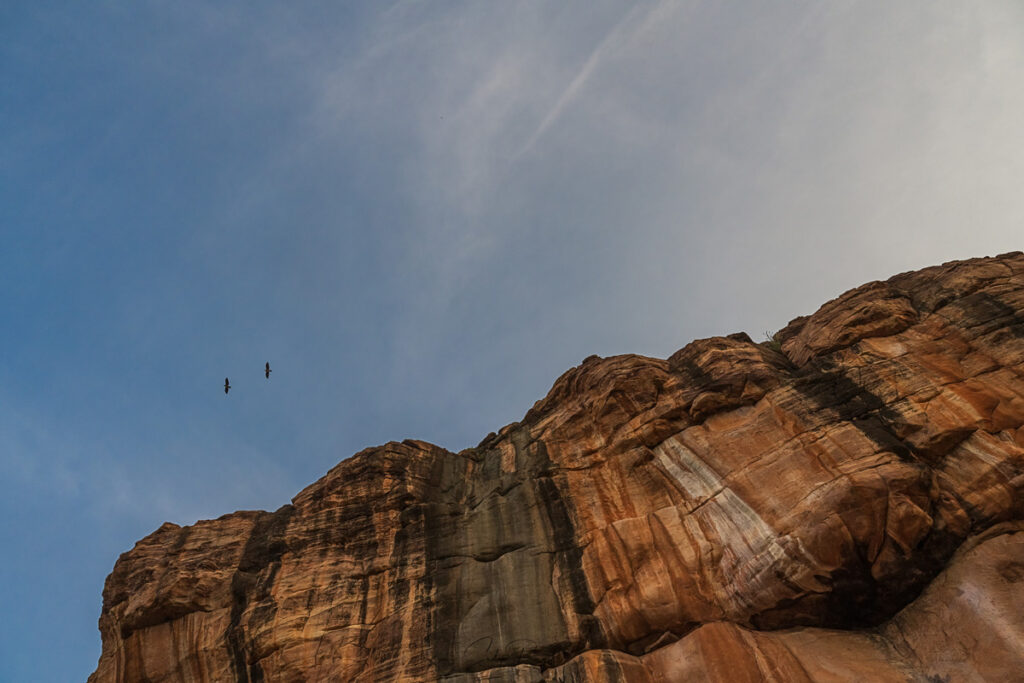
How long does it take to visit all the monuments:
You should keep an entire day for exploring Badami. Try visiting the North Fort, Museum, Bhootnatha Group of Temples, and Agastya Lake in the morning session. Post lunch, explore the cave temples in South Fort.
Places of interest in Badami:
Below, we have discussed what to see in Badami:
1. North Fort:
One of the most important attractions of Badami is the North Fort. Nothing remains much of the fort, but stray structures confirm that the hill was used as a bastion right from the Chalukyan era up to the times of Tipu Sultan and the Marathas.
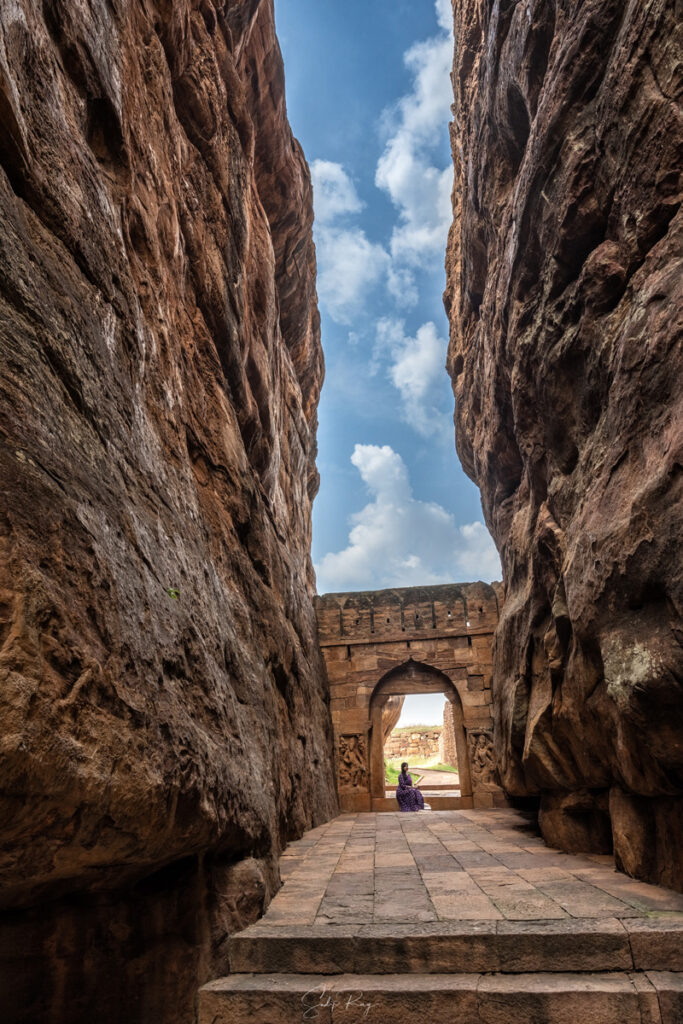
The walk along the steps of North Fort is quite pleasant. You will notice various edifices such as a few open ‘mandapas’ which were probably used by the Chalukyan rulers for ceremonial purposes, two circular granaries, and a ruined complex with a number of chambers.
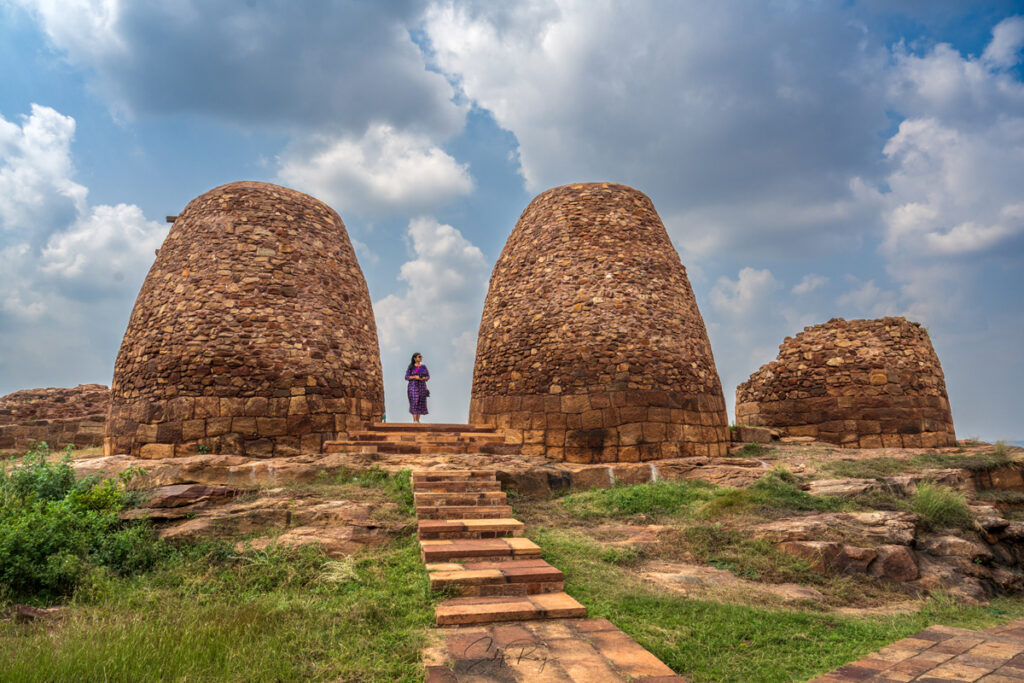
Two Shivalayas are the center of attraction in the North Fort. The Lower Shivalaya is a typical Early Chalukyan structure, though only the towered sanctuary has survived the test of time. Check out the iron canon located beside the temple, which bears the date 1550.
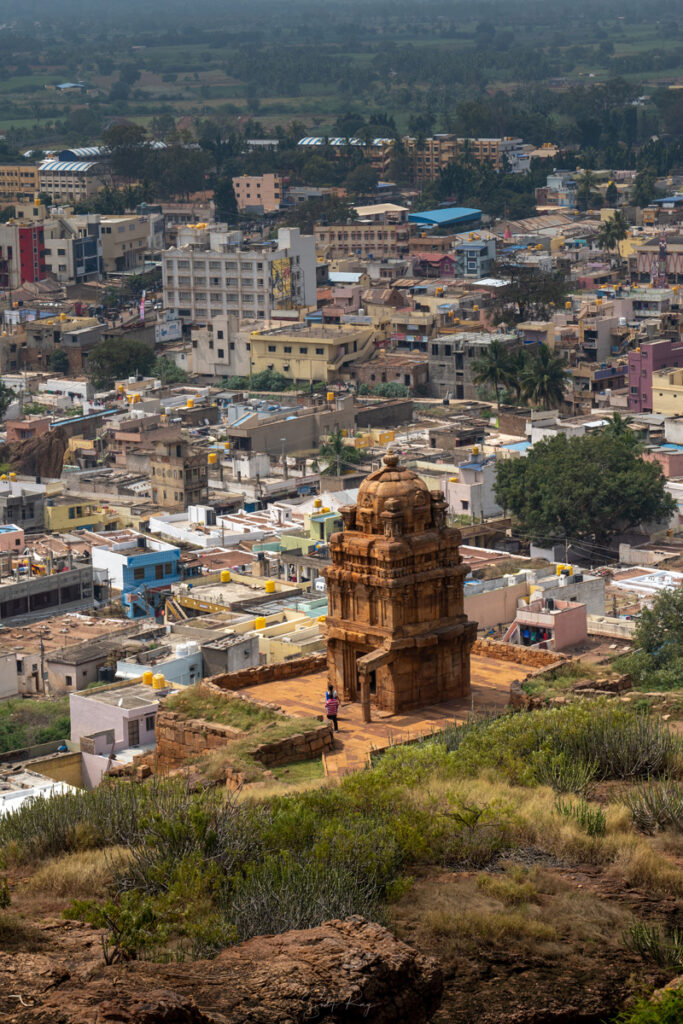
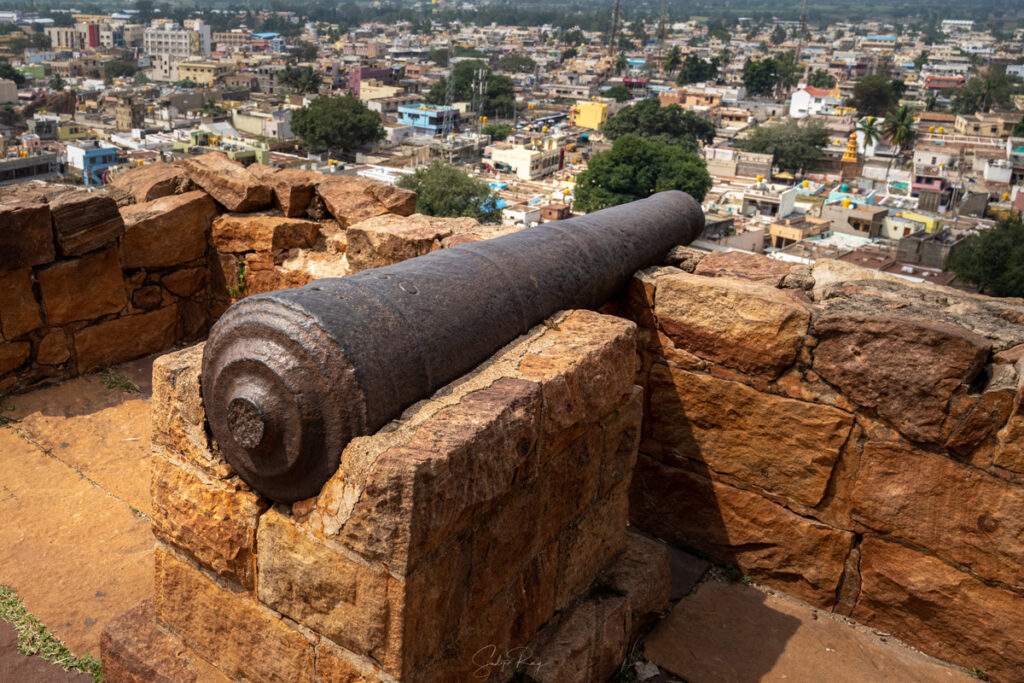
The Upper Shivalaya is also partly demolished. Contrary to its present name, it was originally a Vaishnava temple. It is evident from the wall narrations of Krishna lifting Govardhana, Krishna trampling Kaliya, Narasimha killing Hiranyakashyapa, and so on.
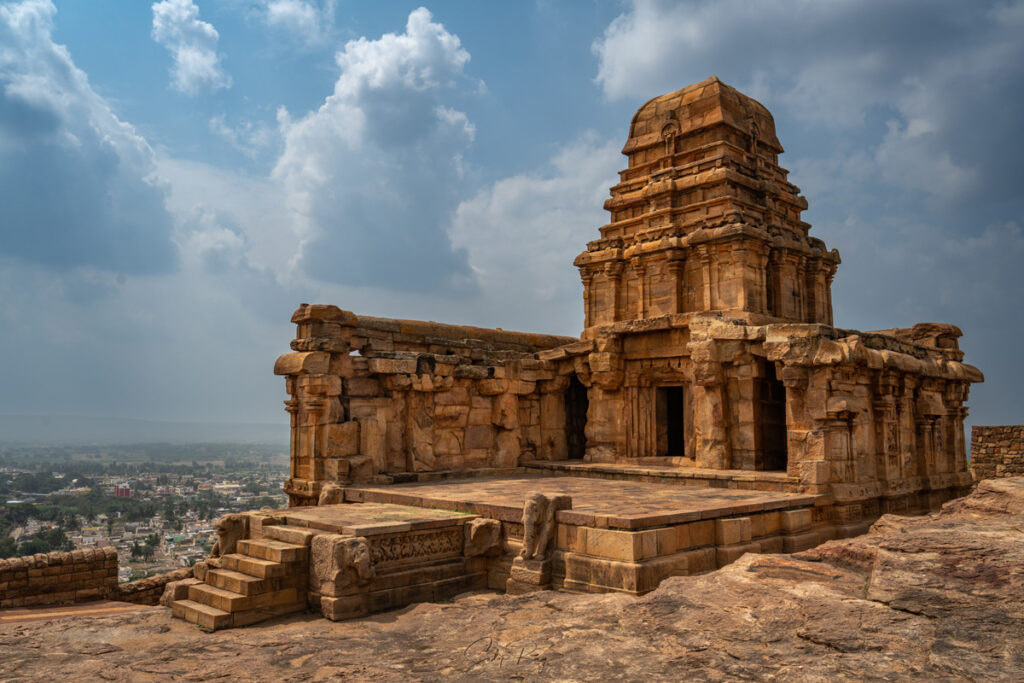
2. Archaeological Museum:
Badami’s museum has some interesting artifacts on display. Such as the Pallava inscription which records the annexation of Vatapi in 642 by Narasimhavarmana I of Kanchipuram, a remarkable manifestation of Lajja Gauri, two panels depicting Shiva aiming an arrow at the Tripura demons and Shiva spearing Andhaka.
3. Agastya Lake:
This picturesque lake is encircled by the Bhutanatha Group of Temples and North Fort. It is believed to possess healing powers. Additionally, a dip in the lake is supposed to relieve all sins. You need to take a walk along the steps of the lake to reach the main Bhutanatha temple.
4. Bhutanatha Group of Temples:
This group of temples is one of the iconic spectacles of Badami. These regal temples will grab your attention while you are exploring the North Fort or the Cave Temples.
This group is further subdivided into two parts – the Eastern or Main Bhutanatha group, and the Northern or Mallikarjuna group. We couldn’t visit the Mallikarjuna group as it was closed. So, we will be discussing our experience at the Main Bhutanatha group.
The main group is situated to the east of Agastya Lake. The complex has several smaller shrines surrounding the main monument. While the smaller temples are attributed to Later Chalukyas, the principal temple is the handiwork of Early Chalukyan architects. It is further characterized by Dravida styled multi-storied tower.
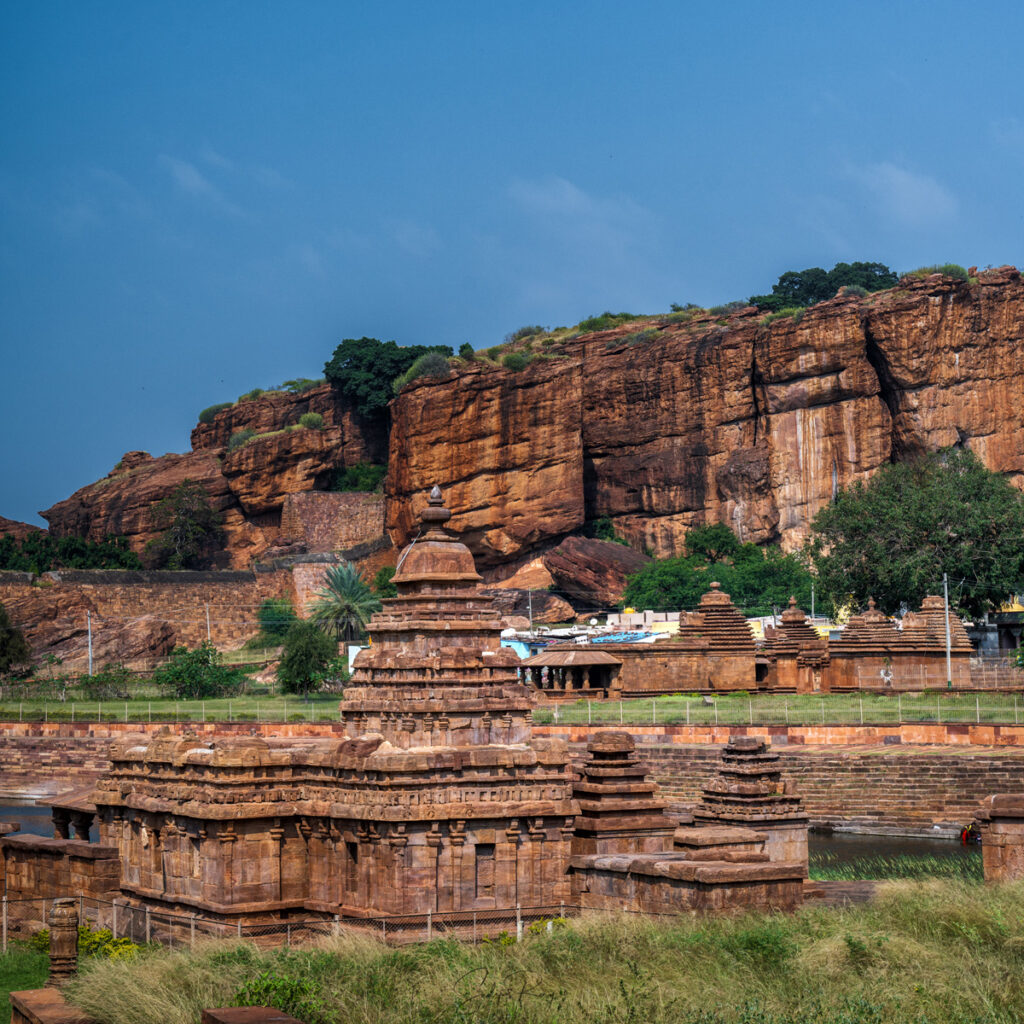
The tour of Bhutanatha Group does not end here. The complex has some more fascinating places. Take the stairs behind the main temple, which will bring you to the rear portion of the complex. Here, you can see numerous sculptures on the cliff. They range from the Dashavatars of Vishnu, Mahisasuramardini, Ganesha, and so on. There are numerous such amateurish carvings in the vicinity. Probably, the artists practiced here before embarking on the main task.
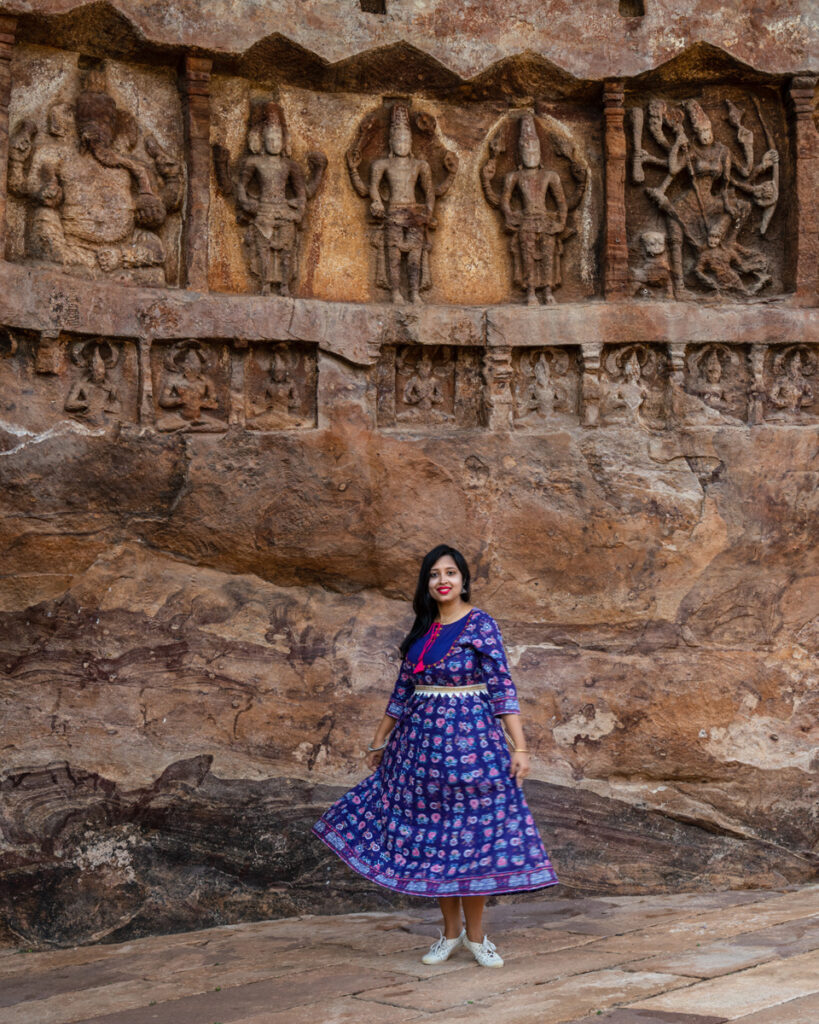
The stairs will bring you further near the lake, where there is a small Vishnu shrine. It preserves a rock-cut icon of Vishnu resting on Adisesha.
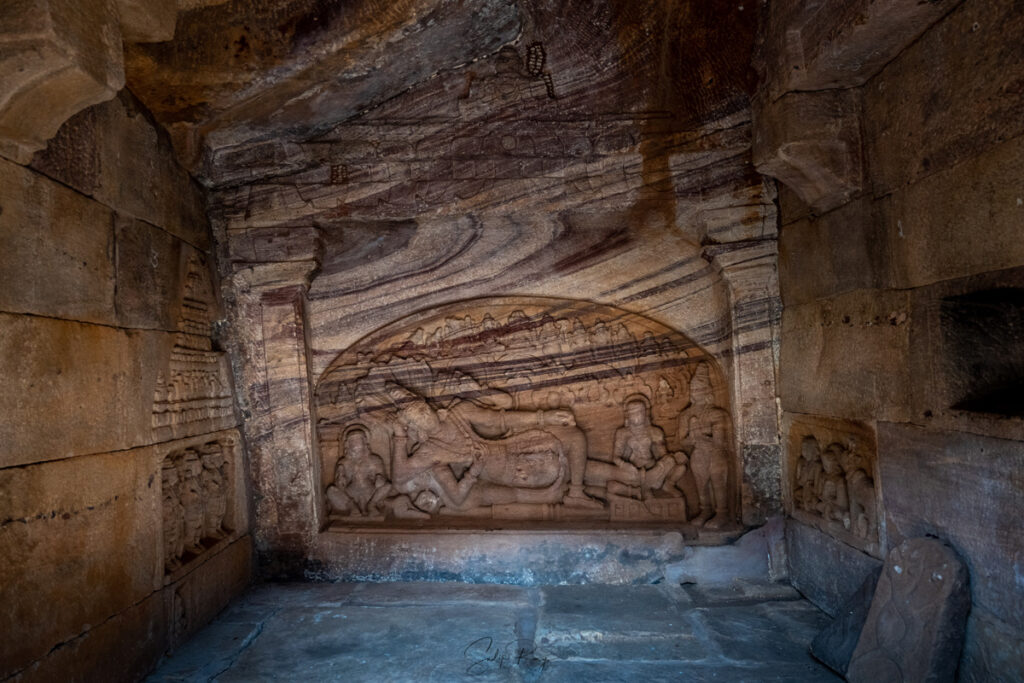
5. South Fort:
The South Fort houses Badami’s most famous and popular attraction – the four cave temples. These four rock-cut monuments are regarded as the first great achievements of the Early Chalukyas. They have been cut directly into the cliff of South Fort. We heartily suggest you to visit it after 3 PM, as the caves glisten spectacularly under the last rays of the sun.
Cave 1:
This is the only cave that has been dedicated to Shiva. The first carving which takes away all the attention is that of an impressive 18-armed dancing Shiva, lying to the right of the cave’s entrance.
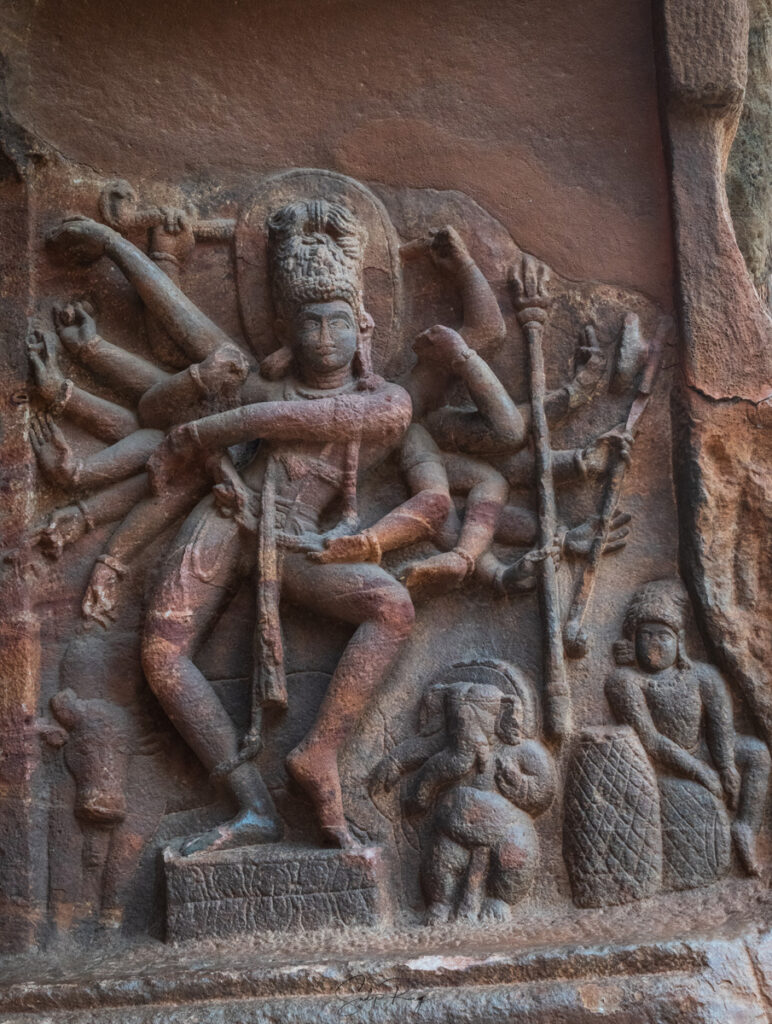
On entering the columned verandah, turn left to marvel at the illustration of Harihara accompanied by Parvati and Lakshmi. The adjacent wall has a ‘dwarapala’, with Shiva-Parvati riding Nandi above.
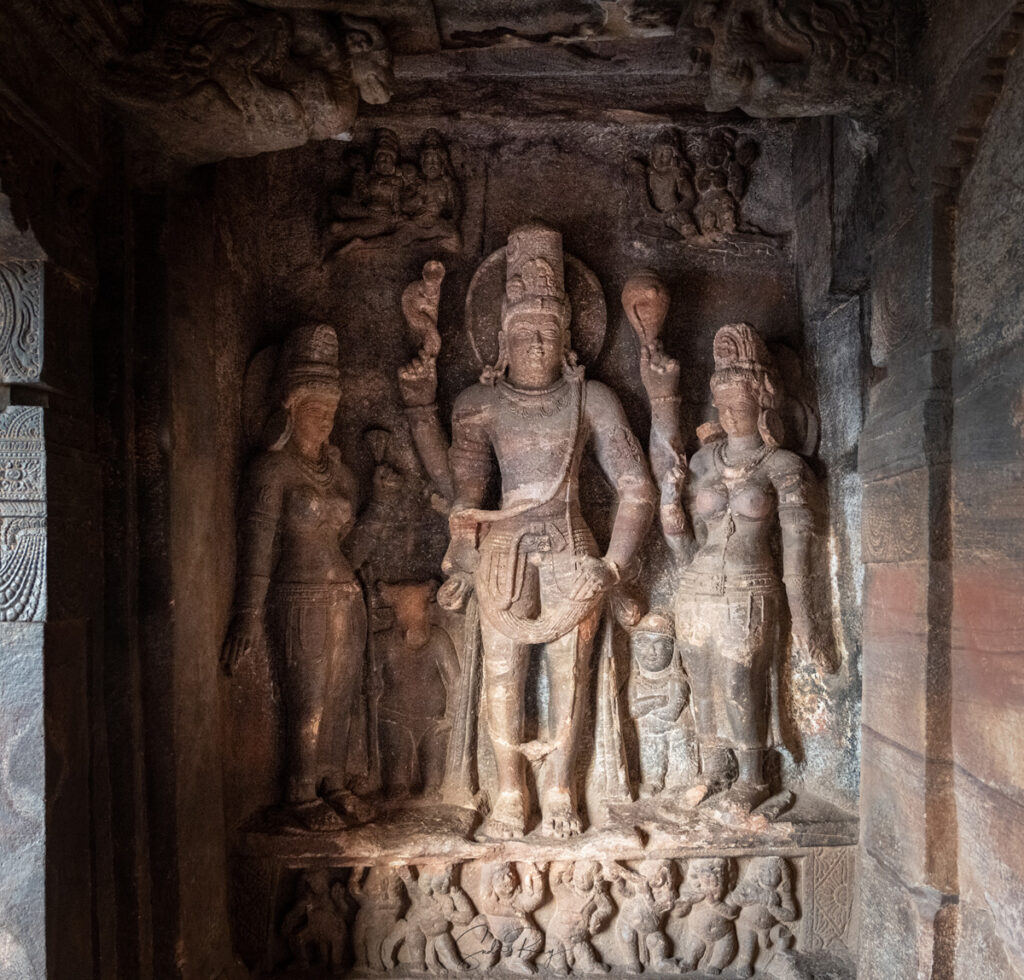
To your right, there lies a sculpture of Ardhanarishwara, escorted by Nandi and Bhringi, and a female attendant.
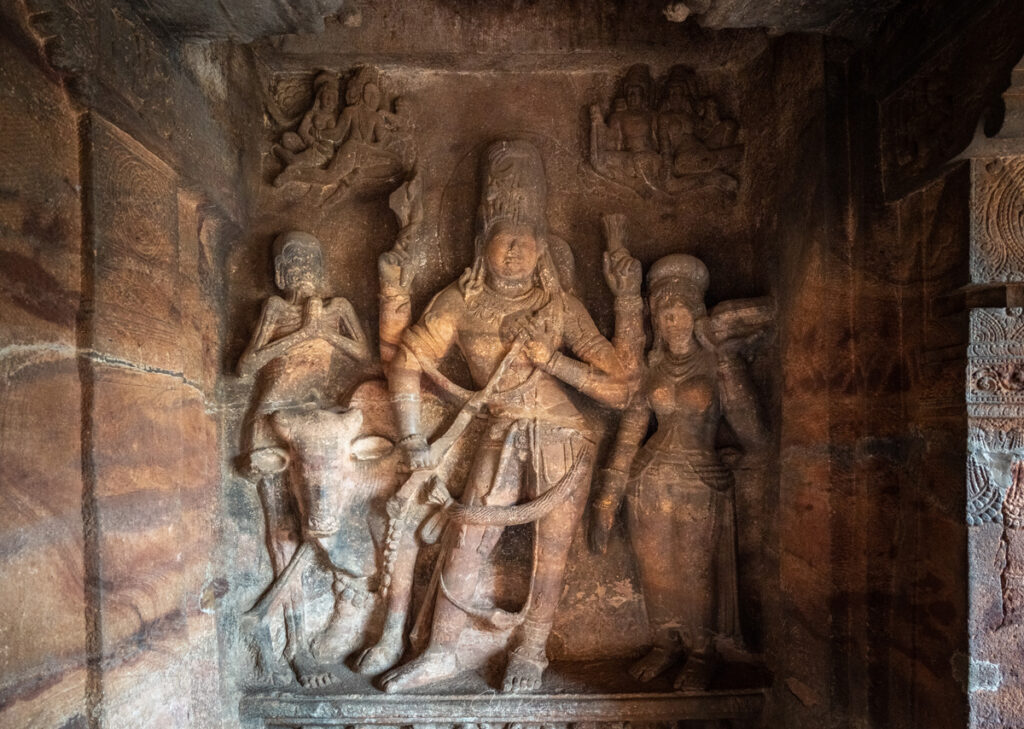
Not only the walls but the ceilings are equally sculpted with precision. Notable among them is a coiled ‘Nagaraja’. Some celestial couples flying can also be seen in the vicinity.
Cave 2:
This cave temple is devoted to Vishnu. On either side of the entrance, notable are the sculptures of two guardian figures holding small flowers.
As you enter the colonnaded verandah, you will be fascinated, on one hand, by an imposing rock carving of Vishnu as Trivikarma with a diminutive Vamana and that of Varaha rescuing Bhudevi, on the other.
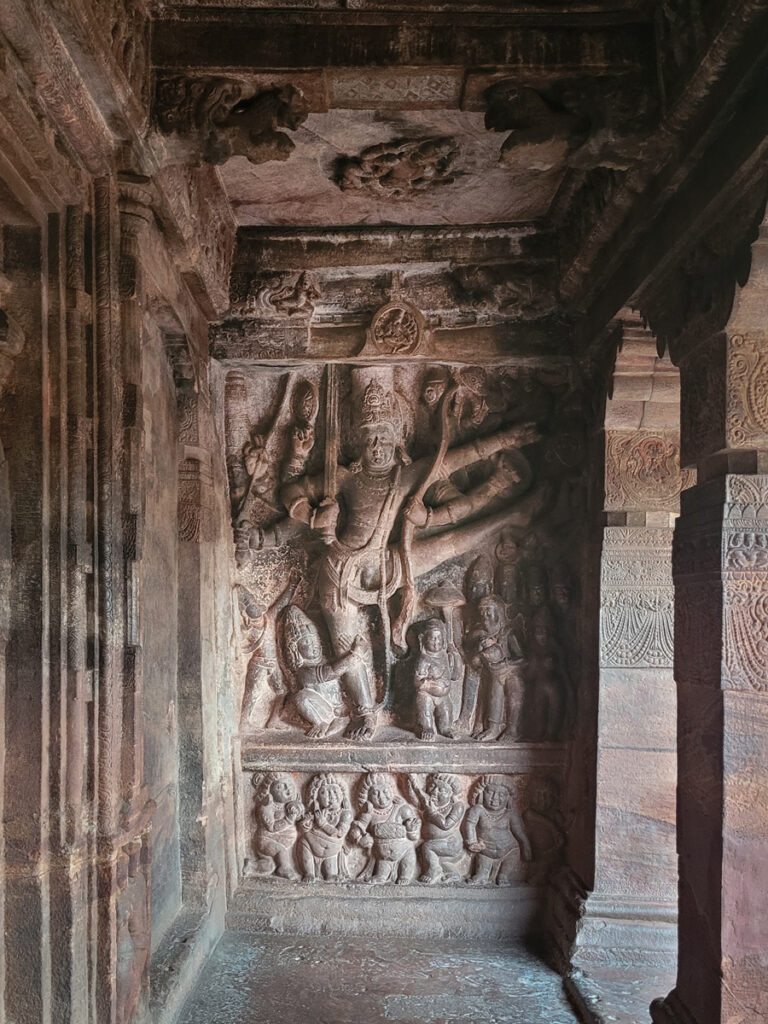
Check out the friezes at the top of the wall that portrays the birth of Krishna, Vishnu asleep on Adisesha, and other Vaishnava legends.
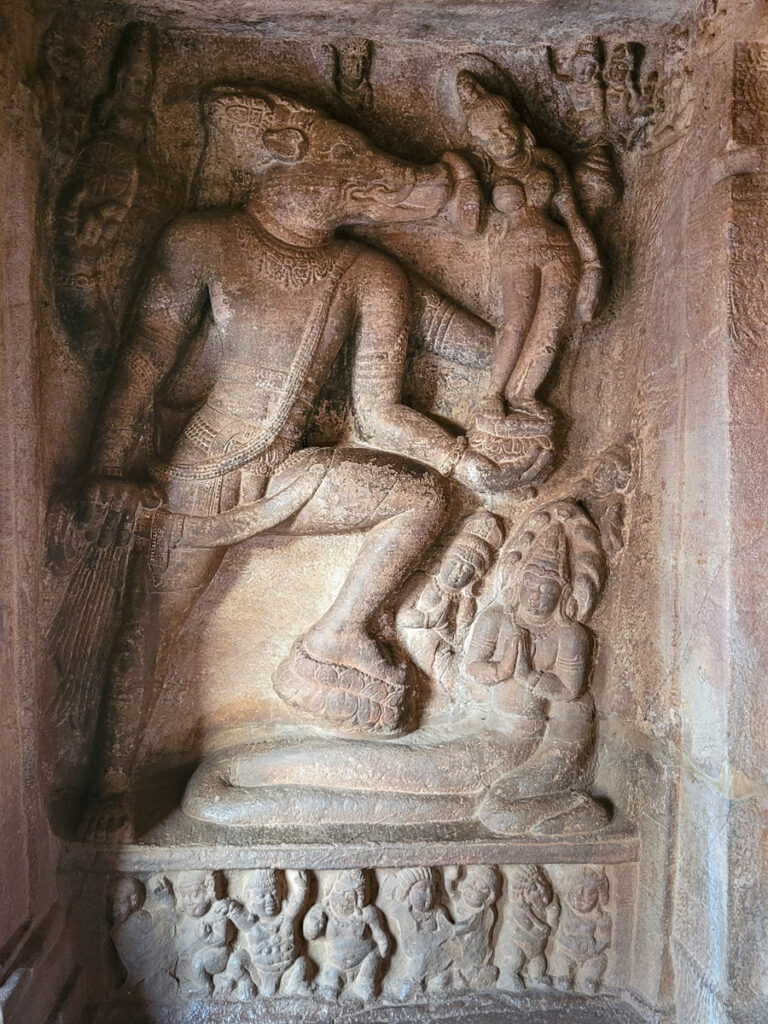
Here also, the ceilings have interesting carvings such as ‘swastika’ and a fish-spoked wheel probably implying Vishnu’s Matsya avatar.
Cave 3:
Dedicated to Vishnu, Cave 3 is the largest and most elaborate of all the cave temples. An outstanding rock carving of Trivikarma adorns the right wall of the entrance.
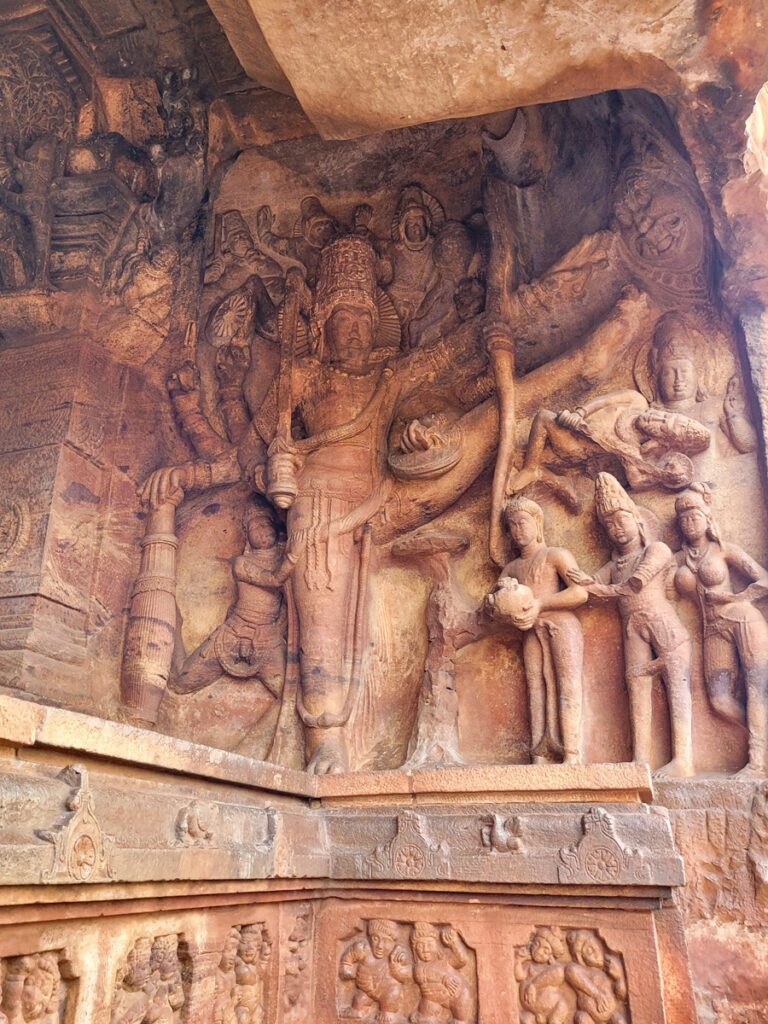
As you enter the verandah, lay your eyes upon the lively sculpture of Vishnu seated majestically on Adisesha. This is perhaps the most striking of all the rock-cut carvings in the South Fort. Varaha avatar of Vishnu lies on the adjacent wall.
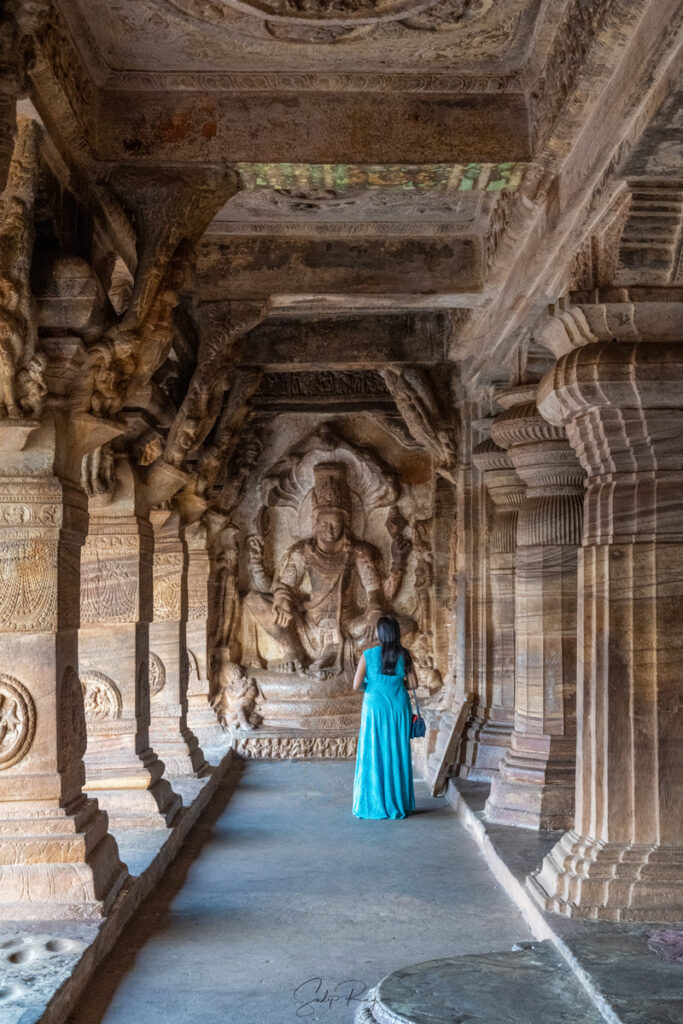
On the opposite end, you will find the fierce Narasimha, leaning on a club. The adjoining wall has a representation of Harihara.
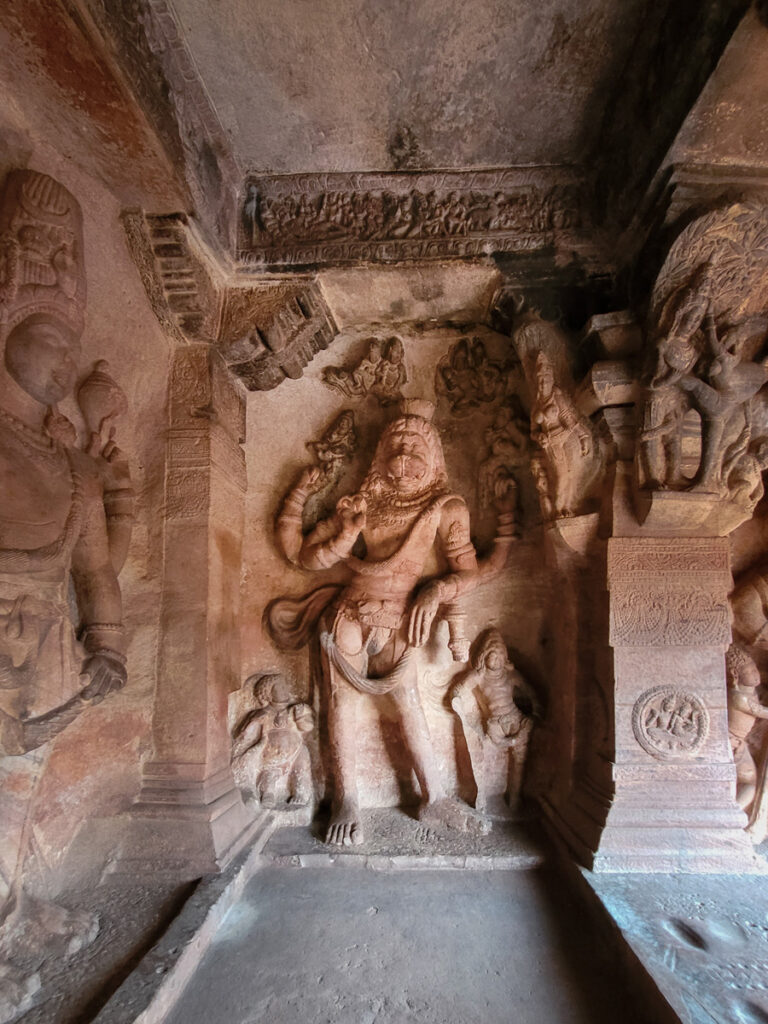
The ceiling panels are also more elaborate here, depicting Kubera, Indra, Brahma with ‘rishis’, Varuna with ‘makara’, and Shiva and Parvati.
You can also make out faint traces of mural fragments on the walls and ceilings of Cave 3.
Cave 4:
This is the only cave that has been pledged to Jainism. It is the smallest and the carvings are also less sophisticated as compared to the other three.
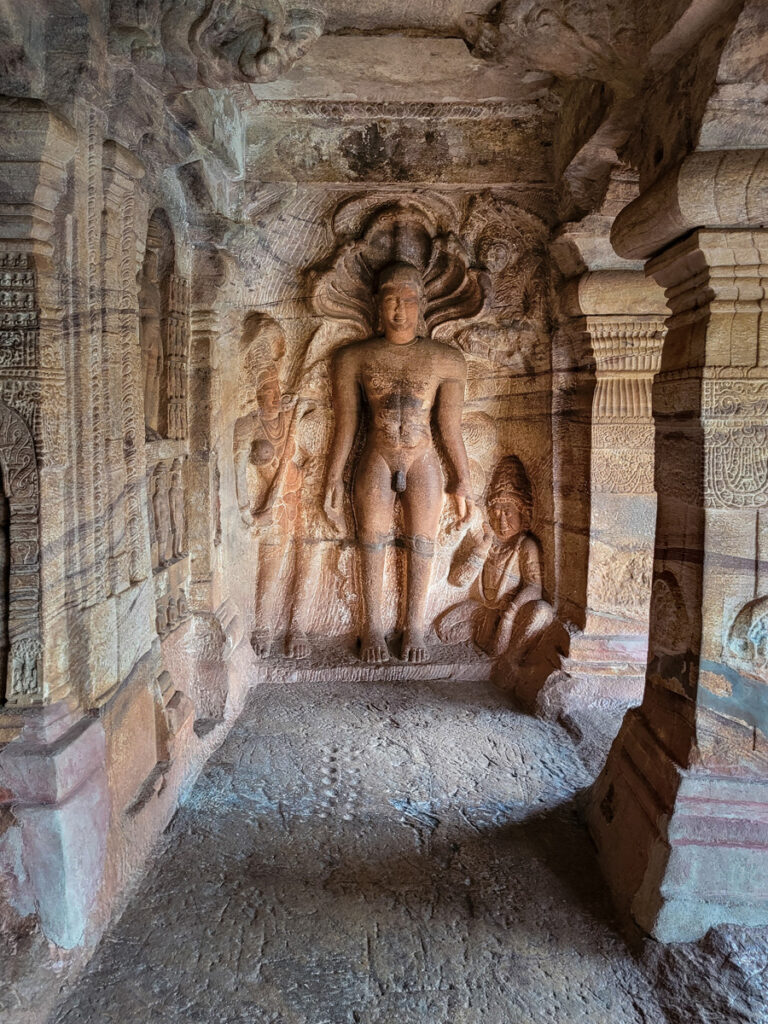
On the left end of the verandah, you will find Bahubali, in his standing meditation posture. While on the right, there is a sculpture of Parshwanatha with a multi-hooded cobra rising over his head.
Along with these two main carvings, there are several other representations of Jaina Tirthankaras, along with a statue of Mahavira placed inside the sanctum.
Things to remember:
1. Like all other Archaeological Museums in India, the one in Badami remains closed on Fridays. It is open on other days from 10 AM to 5 PM. The entry fee is INR 5 per person.
2. The entry fee for Badami’s Cave Temples is INR 40 per person. Visitors can go here from 9 in the morning till 6 in the evening.
3. An entry fee is not required for other monuments of Badami. They generally remain open every day, from 9 AM to 6 PM.
4. The Cave Temples are filled with aggressive and daring monkeys. Keep your belongings safe and close, especially water bottles, food packets, and sunglasses.
5. For traveling around Badami, the only mode of transport is an autorickshaw. We hired one for the entire day. It charged INR 500, including drop-off at Badami rail station.
6. Compared to Aihole and Pattadakal, Badami is a bustling town. You will get every necessary item here, including working ATMs.
7. There are some interesting places nearby Badami. First is Mahakuta, which is 14 km from Badami and is a sacred pilgrimage center. The main attractions here are the 7th-century Mahakuteshvara Temple, Sangameshvara Temple, Virupaksha Temple, and Mallikarjuna Temple. Second is Banashankari Temple, the most popular pilgrimage center of this area. It is 5 km away from Badami. You can also visit Naganathkolla, which lies midway between Mahakuta and Banashankari and has the Naganatha Temple, hailing from the early Chalukyan times.
8. There are also several pre-historic sites around Badami such as Sidilaphadi, Ranganathgudda, and Aralitirtha. However, they are mostly isolated. We strongly suggest not venturing alone here and taking a local guide for visiting them.



